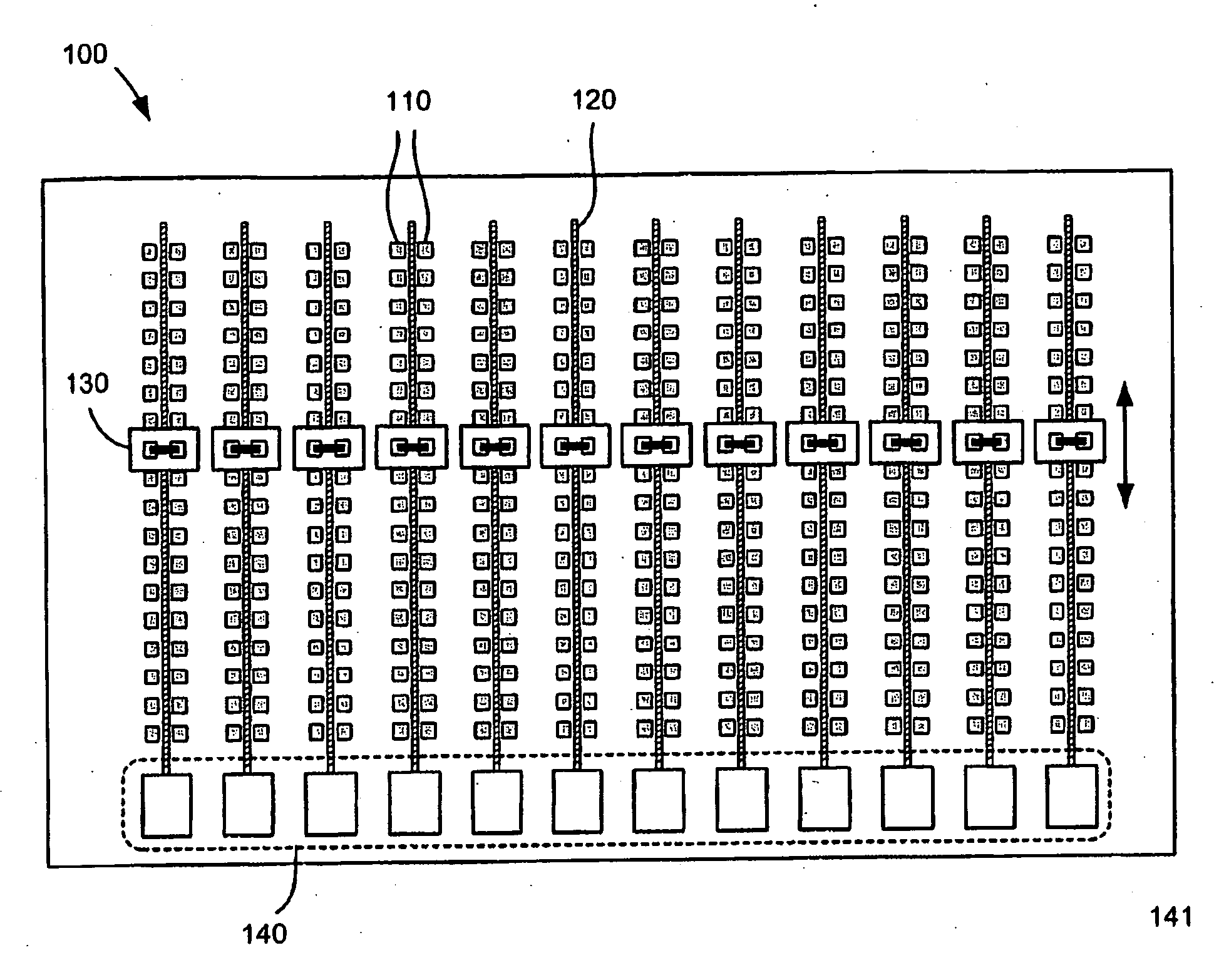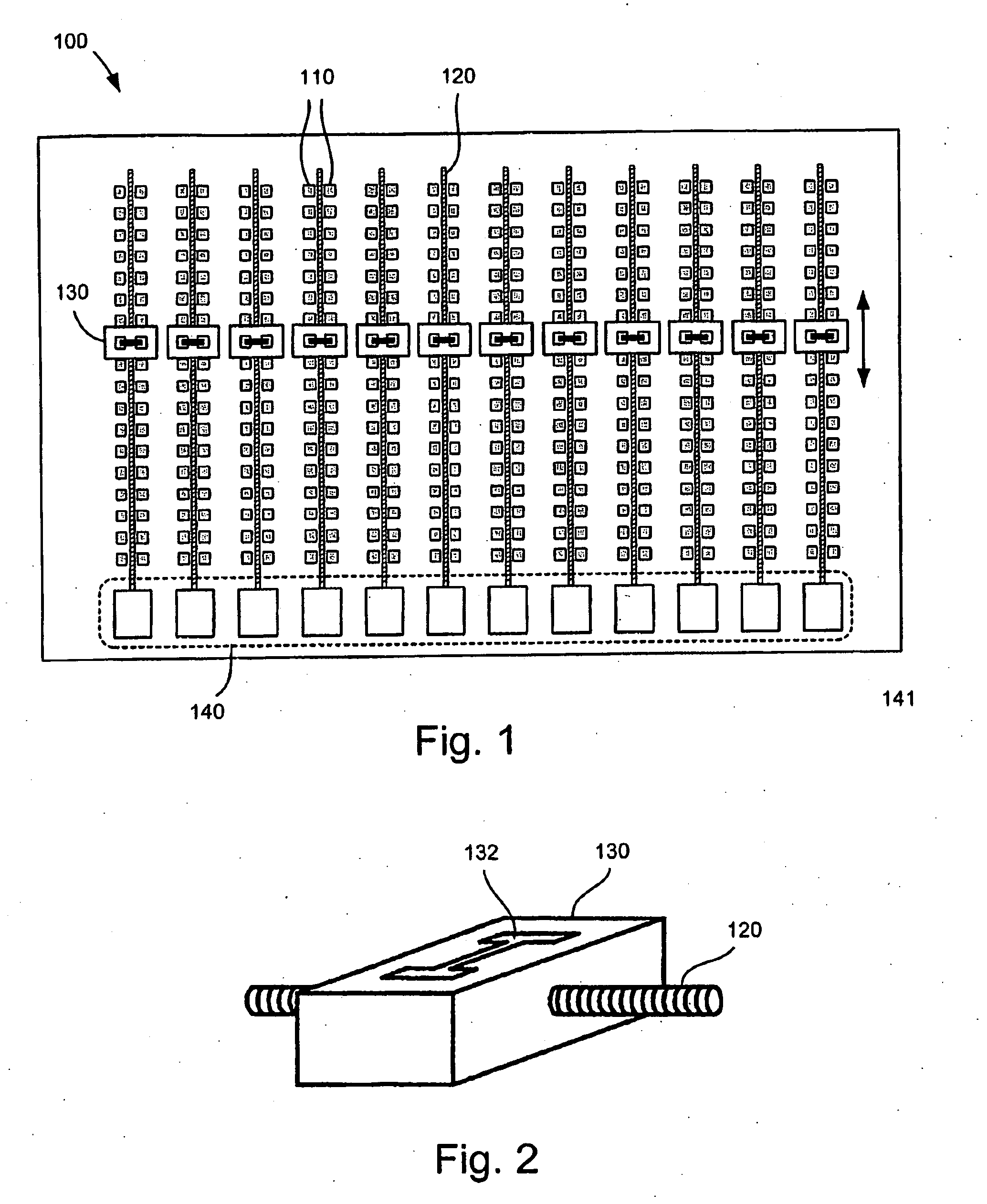Drive and positioning method and system for automated switch matrix
a switch matrix and drive technology, applied in the field of telecommunication network infrastructure, can solve the problems of limiting the capacity of the switch matrix, one of the most significant costs faced by telecommunication providers, and generally very difficul
- Summary
- Abstract
- Description
- Claims
- Application Information
AI Technical Summary
Benefits of technology
Problems solved by technology
Method used
Image
Examples
first embodiment
[0022]FIG. 1 shows a diagrammatic top view of an exemplary automated switch matrix operating in accordance with the invention. The switch matrix 100 is configured for cross-connecting a number of input line pails to a number of output line pairs. The switch matrix board comprises a plurality of electrically conducting contact pads 110 that are formed into a printed circuit board (PCB). The contact pads are arranged into a plurality of longitudinal contact trains by which an electrical connection between them is made when a contact sledge 130 is mechanically slid over the contact pads. The contact pads are connected through the PCB to internal conductor layers that interconnect with other contact pads. It should be noted that although the switch matrix of the embodiment is configured for cross-connecting line pairs, it is possible for the matrix to connect any line in a set of input lines to any line in a set of output lines in a so-called any-to-any configuration. Each of the contac...
second embodiment
[0024]FIG. 3 is a diagrammatic top view of the exemplary switch matrix operating in accordance with the invention. In the embodiment, the drive means comprises two stepper motors (150,152) i.e. a first motor driving a top lateral positioning screw 154 and the second motor drives a bottom lateral positioning screw 156 (not shown). The lateral positioning screws 154 and 156 operate together to laterally position and induce stationary rotation in lateral drive gear 158. The stepper motors (150,152) operate in combination to move the lateral drive gear 158 to a position where it can engage a specific sledge positioning screw gear 160. Once the lateral drive gear 158 is selectively positioned it engages and rotates the sledge positioning screw gear 160 causing the contact sledge 130 to move longitudinally to cross-connect the desired lines.
[0025]The motion of the lateral drive gear 158 is motivated and controlled in the following manner. For example, when only one of the stepper motors i...
third embodiment
[0029]FIG. 6 shows a side view of the drive mechanism using a single drive motor together with a clutch assembly operating in accordance with a Drive motor 150 rotates the upper and lower lateral positioning screws 154 and 156 via a magnetic clutch assembly 180 in order to move the lateral drive gear 158. By way of example, the lateral drive gear 158 moves right when the upper lateral positioning screw 154 rotates CW and the lower lateral positioning screw 156 is not rotating. This occurs when the drive motor 150 is rotating and the magnetic clutch 180 is disengaged. Similarly, leftward motion of the lateral drive gear 158 is induced when the upper lateral positioning screw 154 rotates CCW with a stationary lower lateral positioning screw 156 caused by a disengaged clutch. Once the lateral drive gear 158 is in position stationary rotation is induced when the upper and lower lateral positioning screws rotate in opposite directions, which occurs when the magnetic clutch 180 is engage...
PUM
 Login to View More
Login to View More Abstract
Description
Claims
Application Information
 Login to View More
Login to View More - R&D
- Intellectual Property
- Life Sciences
- Materials
- Tech Scout
- Unparalleled Data Quality
- Higher Quality Content
- 60% Fewer Hallucinations
Browse by: Latest US Patents, China's latest patents, Technical Efficacy Thesaurus, Application Domain, Technology Topic, Popular Technical Reports.
© 2025 PatSnap. All rights reserved.Legal|Privacy policy|Modern Slavery Act Transparency Statement|Sitemap|About US| Contact US: help@patsnap.com



